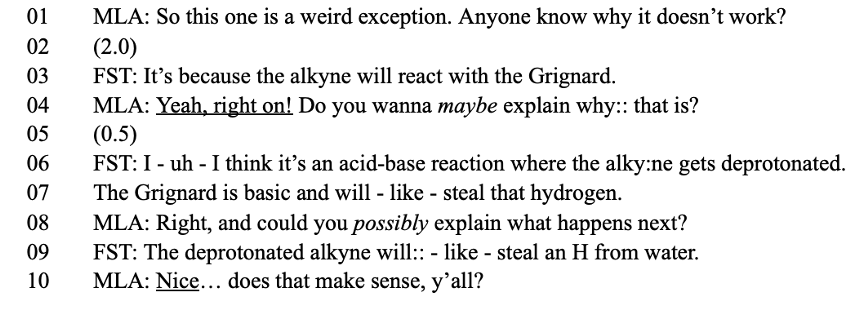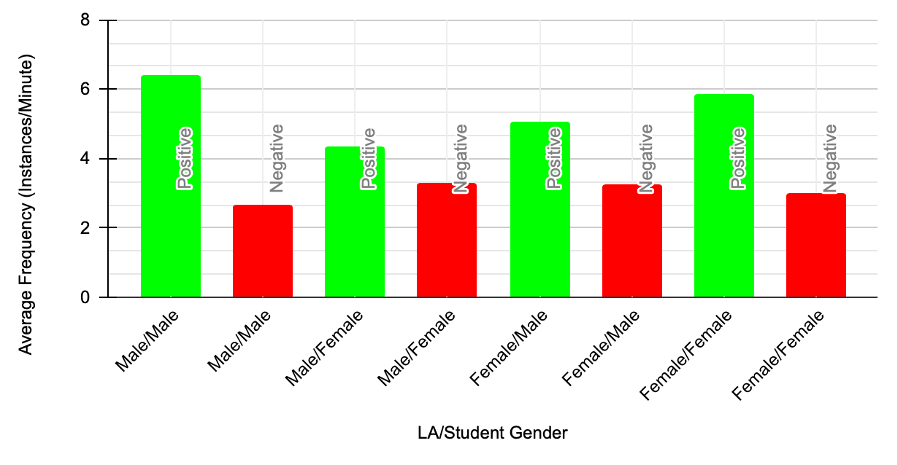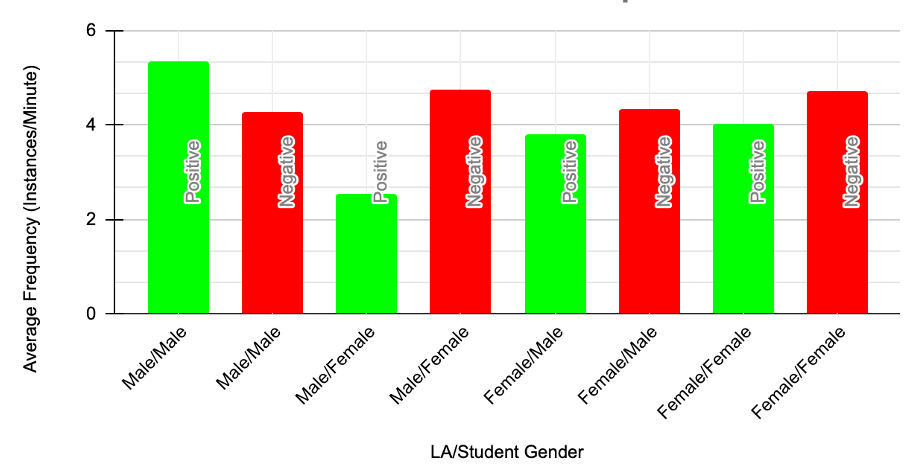Anonymous Author
The Learning Assistant program at UCLA aims to create a positive and engaging learning environment where undergraduate students who have mastered a certain course’s material can help teach that material to students who are currently in the class. This study observed ten undergraduate Learning Assistants at UCLA to determine whether there was a difference in how often positive and negative politeness were used in discussion sections. The differences in their usage were looked at from a gendered perspective: the study sought to determine whether similarities or differences in gender resulted in one kind of politeness getting used more often than another. The study ultimately determined that, when looking at same-gendered interactions, positive politeness was used more commonly in same-gendered interactions than different-gendered interactions. However, what about negative politeness? Would gender differences potentially make Learning Assistants act with more hesitancy, and, therefore, use it more frequently? This article provides the answer to this question, as well as goes into greater depth about this study’s intriguing findings.
Background
At UCLA, undergraduate students who have excelled in certain STEM classes can return to those courses and help teach current students as part of the Learning Assistant program. As part of the Learning Assistant program, undergraduate Learning Assistants attempt to foster an inclusive learning environment where students can better understand the topics covered in their respective courses. They are trained to promote an interactive environment, even through Zoom, as well as use a Socratic questioning style which encourages students to think independently (Talbot et. al 2015). As seen in this video, Learning Assistants are encouraged to let students figure out the answer themselves rather than feeding it to them. Promoting interaction and encouraging independent thinking, according to the program, force students to think more critically about the content they have to learn, and, as a result, develop a more solid understanding compared to if one were to just passively teach it (Furtak and Kunter, 2012).
However, a problem potentially arises when looking at the interactions between Learning Assistants and students themselves. In order to promote inclusivity, LAs are encouraged to act with kindness and politeness towards the students (Sellami et al., 2017). Creating a warm, supportive atmosphere has been shown to improve with facilitating student learning (Jardine et al., 2020). However, the kinds of polite statements which the Learning Assistants use may differ based on their gender, as well as potentially even the gender of the student who they are addressing. This may potentially lead to differential learning outcomes based on gender due to different levels of support from the Learning Assistants. This study sought to answer one major question: do LAs tend to use a certain kind of politeness more than another when students identified as the same gender as themselves?
Methodology
This study collected data from ten Learning Assistants for an organic chemistry class, five male and five female, who agreed to participate. These Learning Assistants recorded their discussion sections, which were held over Zoom, and sent them as attachments in emails for this study’s analysis.
When analyzing the conversations that Learning Assistants had with students, this study looked for two main kinds of politeness: positive and negative politeness. Each of these was categorized in the following ways (Brown and Levinson, 1987):
Positive Politeness: Words of affirmation towards a person who is part of an in-group or considered a friend. A very casual and friendly statement with the intent of encouragement or support.
Negative Politeness: A more formal and avoidant strategy used to maintain distance between the user and the target. There is more restraint with negative politeness and, occasionally, apologetic wording. It may involve hedging, which is used to add uncertainty or decrease assertiveness to a particular statement.
When analyzing each of the Zoom recordings, this study categorized Learning Assistant-student interactions based on the LA’s gender, the student’s gender, and whether the student’s provided answer was correct or incorrect. The number of instances of each kind of politeness was tallied for each recording. This was then divided by the number of minutes the LAs spent talking to the students in order to obtain frequencies for each kind of politeness. The frequencies for each LA were averaged, and then analyzed as data below.
Analysis
We can use the technique of discourse analysis (Janks, 1997) to analyze the conversation in Example 1 between a male Learning Assistant and a male student.
Transcription Key:
MLA indicated Male Learning Assistant
MST indicates Male Student
FST indicates Female Student
(time) indicates a pause for [time] seconds
- indicates a short, untimed pause
: indicates a stretched syllable
(.h) indicates an inhalation
Underline indicates positive politeness phrases
Italics indicates negative politeness phrases
For the purposes of confidentiality, the actual names of the students and LA will be replaced in conversations with MST/FST/MLA, respectively.

In Example 1, the male Learning Assistant uses four instances of positive politeness with the male student. When looking at this conversation with the idea of a student’s perceived levels of support in mind, one can see how this student would feel very supported. The casual language which the Learning Assistant uses, such as “dude,” as well as the phrases of encouragement such as “You got it!” and “Exactly!” would most likely make this student feel as if his answer was validated and that he belonged in such a learning environment. The four instances of positive politeness, marked using an underline, reaffirm the student that he is correct. The Learning Assistant’s action of making this student more comfortable in the discussion section may, in turn, make him feel more confident about his ability to succeed in the class.
Now let’s take a look at an example of a conversation where the same male Learning Assistant interacts with a female student:

Much like the male student from the previous example, the female student in Example 2 also answered the male Learning Assistant’s question correctly. However, the Learning Assistant’s response towards her answer was not as comforting and casual as it was with the male student. For example, he only used two instances of positive politeness compared to the four he used in the previous example. Additionally, he now uses two instances of negative politeness, indicated in italics, when asking her to further explain her answer.
Similar overall trends to the two examples above are seen when looking at the combined data of this study. This data is pictured in the two graphs below:

There are two major points of interest in Figure 1. First, when looking at each interaction, every correct response yielded more frequent positive politeness than negative politeness. However, more importantly, one can notice that male LA/male student and female LA/female student interactions have more frequent use of positive politeness than the other two kinds of interactions with different LA/student genders. This finding supports the idea that positive politeness is more commonly used when an LA interacts with a student of the same gender.

The results for incorrect responses in Figure 2 are not as conclusive as they were for correct responses. Once again, this data shows that positive politeness is used more frequently when a student and LA have the same gender compared to when they have different genders. More importantly, however, is the fact that female/female interactions had more instances of negative politeness than female/male interactions here. This finding disproves the idea that negative politeness is dependent on gender in interactions. Unlike positive politeness, which was higher in same-gendered interactions for both examples, negative politeness does not have any trend with relation to gender.
Conclusion
After analyzing the data, the study ultimately concluded two things. The first conclusion reached was that positive politeness is used more frequently when Learning Assistants interact with students who share the same gender as them. In addition to this, however, the study also concluded that the frequency of negative politeness is independent of the Learning Assistant and student’s genders.
The finding that positive politeness is higher in same-gendered interactions may have implications with regard to perceived student support: students may feel more supported if they interact with LAs who identify with their same gender compared to LAs who do not. Increasing awareness of this issue amongst LAs may allow them to be cognizant of the existence of such a bias, and therefore, would help them know to be just as supportive towards differently-gendered students. Similar future studies should include non-binary participants in order to extend the results past the gender binary.
References
Brown, P., & Levinson, S. C. (1987). Politeness: Some Universals in Language Usage. In Politeness: Some universals in language usage (pp. 311-323). Cambridge: Cambridge University Press.
Furtak, E. M., & Kunter, M. (2012). Effects of autonomy-supportive teaching on student learning and motivation. The Journal of Experimental Education,80(3), 284-316. doi:10.1080/00220973.2011.573019
Janks, H. (1997). Critical discourse analysis as a research tool. Discourse: Studies in the Cultural Politics of Education,18(3), 329-342. doi:10.1080/0159630970180302
Jardine, H., Levin, D.M., & Cooke, T. (2020). Group Active Engagement in Introductory Biology: The Role of Undergraduate Teaching and Learning Assistants.
Sellami, N., Shaked, S., Laski, F. A., Eagan, K. M., & Sanders, E. R. (2017). Implementation of a learning assistant program improves student performance on higher-order assessments. CBE—Life Sciences Education,16(4). doi:10.1187/cbe.16-12-0341
Talbot, R.M., Hartley, L., & Wee, B. (2015). Transforming Undergraduate Science Education With Learning Assistants: Student Satisfaction in Large Enrollment Courses. The journal of college science teaching, 44, 24.